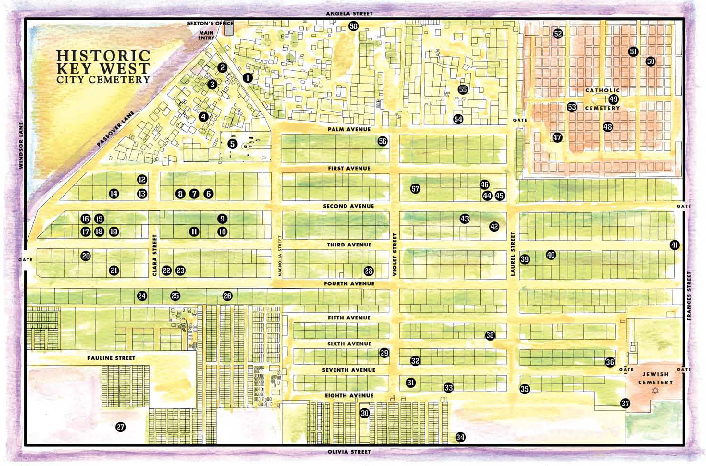Key West City Cemetery
Walking Tour

The Key West City Cemetery was established in 1847 following the disastrous hurricane of October 11, 1846. According to prominent attorney and port inspector Stephen Mallory, "The effects ~ the hurricane was terrible. The grave yard ~ this town on a high sand ridge on the Southern part ~ the Island was entirely washed away, and the dead were scattered throughout the forest, many ~ them lodged in trees." The hurricane destroyed several burial grounds, including the one referred to by Mallory, necessitating establishment of a new city cemetery. In 1847, the City purchased a 100 lot tract in the center of town for $400. As originally planned, the northwest triangular section featured curvilinear streets still partly in evidence by the burial pattern that resulted in that area. Family plots were delineated in a gridded central section with the northern public section marked by numbered quadrants. Several years later, the City added 233 lots south of the family plots. In 1868, a separate Catholic Cemetery measuring 300 feet square was created along Frances Street. The Jewish Cemetery is a small section in the southeast portion of the property. The Key West Cemetery reflects an era of cemetery reform that occurred throughout the nation. "The Rural Cemetery Movement" began in the 1840's as America's cities began establishing large, park-like cemeteries outside their boundaries. These expansive, landscaped cemeteries developed as a response to overcrowded private and churchyard cemeteries and to satisfy the need for culture in America. Cemeteries became peaceful parks for appreciating works of art and enjoying beautifully landscaped grounds. Varied artistic styles and burial methods are evident in the City Cemetery. Monuments were shipped to the island to mark the graves of the wealthy and prominent. Locally produced grave markers are of brick, cement or tile. Each element on a grave has meaning. Many of the symbols provide insight into a person's career, family life, participation in the community, and personal sentiments. The above map can be found at the entrance to cemetry on Passover Lane. The walking tour is operated and managed by the Historic Florida Keys Foundation.